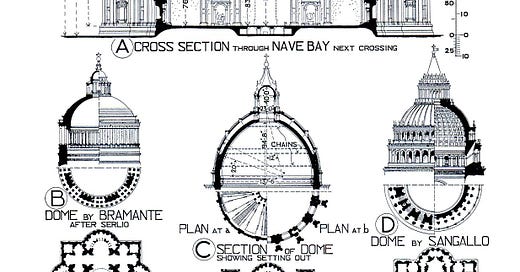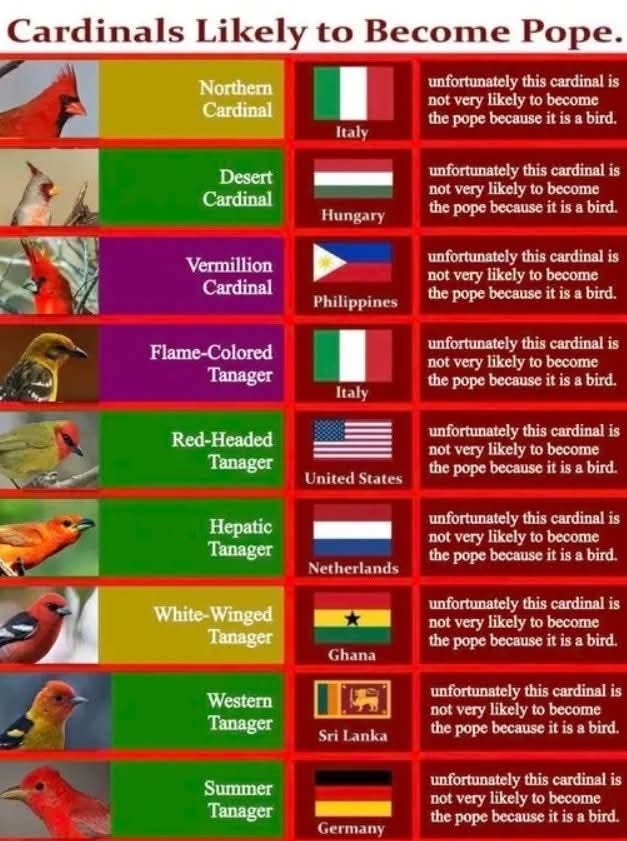O God, who chose your servant Pope Francis from among your Priests and endowed him with pontifical dignity in the apostolic priesthood, grant, we pray, that he may also be admitted to their company for ever. Through Christ our Lord. Amen.
— USCCB, “Novena in Memory of Pope Francis,” Day 3 (April 28th, 2025)
The papal interregnum has occasioned serious reflection on the currently-existing regime of the Catholic Church. Here are a few I found particularly insightful.
Susan Hanssen, writing at Crisis Magazine, notes that “all three of the last popes—John Paul II, Benedict XVI, and Pope Francis—were men very much shaped by the 20th rather than the 21st century.” We have not yet had “a genuinely third-millennium pope,” that is,
a pope who is “of” the John Paul II Generation, who will amplify that generation’s full-throated, unapologetic embrace of the Church’s liturgy, tradition, and moral and social teaching on the centrality of the family as the primary unit of society.
And what was the dominant regime of the 20th century? What did its three great state ideologies—Communism, Fascism, and Liberalism—have in common?
, writing at Compact, describes “Pope Francis’s Managerial Revolution.” As Pinkoski explains:Managerialism is, at its core, the prioritization of process over product. […] Managerialism avoids the overt frictions and conflicts that come from the pressure to achieve specific objectives. The casualty of managerialism is personal responsibility. By resorting to mutable guidelines, by preferring vague communication, managerialism teaches the art of talking in circles, of never really saying anything for which one can be held accountable. Francis’s governance of the Church reflected these managerial priorities. He was deliberately ambiguous in doctrinal statements ...
Similarly, Jude Russo of The American Conservative argues that “power, not ideology, was the late pope’s lodestar”:
The constant reshuffling of the curia, disrupting long-standing power-bases and not coincidentally putting egg on the faces of prominent papabiles; foregoing elevating bishops from the usual places to the cardinalate, instead preferring to hand out red hats in far-flung parts of the world with weak and poorly understood interests; throwing the underground Chinese Church under the bus in the badly conceived and executed deal with the PRC; these are all moves to ensure that there was no power but Francis’s power in the Roman fold. The shabby handling of traditionalists is best explained along these lines. Even as he crushed traditionalists within the Church, which disproportionately affected the wealthy, powerful, and relatively conservative American Church, he cultivated friendly relations with the traditionalist Society of St. Pius X. By granting them faculties for confession, he functionally brought them out of schism, but their canonical status remains irregular and confusing. Where the law is unclear, power is the judge’s.
Looking to the future, Jeffrey Pojanowski at The Public Discourse hopes that our next pope will reject the “disenchanted angelism” of our age:
This is not a new program, but a perennial proposition that is providentially apt for our times. And the most important thing for the Church to do today is to present it and be aggressively present with it. To be itself, but even more so. […] As banal as it sounds, the mission of the Church today boils down to being there: being there for a dislocated and disembodied world that needs to know that Being is there.
I won’t try my own hand at predicting the results of the upcoming Conclave, though I will recommend Edward Pentin’s College of Cardinals Report. (See his announcement and description of the project here).
Of all the predictions I’ve seen, the following guide seems most reliable:
Many Catholics protest the media habit of imposing political categories (right and left, conservative and liberal) on popes and papabili.
This protest is good as far as it goes. The “business” of the papacy is not reducible to socio-economic and political policies. Whatever political terms do seem to describe certain policies of a given papacy are unlikely to capture other policies. The habit of applying essentially modern, American, and temporal terms to an ancient, international, and spiritual institution is particularly inapt. Above all, the Church’s Magisterial teaching on faith and morals, which the Pope is charged with guarding, articulating, and transmitting, is derived from the person of Jesus Christ, the revelation of Holy Scripture, and the millennia-long unfolding of Tradition—not the program of a political party or the system of an ideologue.
That said, the Church is not hermetically sealed from the world of temporal politics. Nor do papal elections occur in such a vacuum.
In the earliest Christian centuries—before there were such things as cardinals and conclaves—the clergy and the great families of Rome played major roles, for better or for worse, in papal elections. Throughout the medieval and modern periods, the great powers of European Christendom exerted their influence over such momentous decisions, sometimes in crude and spectacular ways, sometimes more subtly. Diminished though the influence of the Church in general and the Papacy in particular may be, why would we expect the great temporal powers of our time—states, corporations, and international organizations—to disregard the question of who becomes the next Pope?
Why, for that matter, would we expect (or even want) the cardinals themselves, who are soon to be locked up (that, after all, is the meaning of a “conclave”) to elect our next Pope, to be willfully ignorant of all manner of political considerations? Wouldn’t such ignorance impair the ability of the wisest among them to decide most prudently on the visible leadership of the Church in this age?
More generally, as Andrew Willard Jones has described, Church governance itself has developed over time, often in concert with or direct reaction to the re-ordering of temporal power: e.g., Papal power was centralized in the modern Church in response to the rise of powerful and centralized nation-states, through some combination of self-defense and as a result of the logic of diplomatic agreements with newly powerful kings and princes who were happy to see Rome empowered at the expense of local bishops.
In several ways, then, the real disposition of temporal power has always mattered for the Church’s decisions on its own governance and conduct.
For the last 80 years, the United States has been the dominant imperial power in the world generally and over the civilization formerly known as Christendom in particular. Without asking in which direction the lines of causation flow, it would be interesting to consider what correspondence, if any, there has been between American politics at the highest level and Church leadership at the highest level.
In his chapter on “The Postmodern Church,” Jones describes the managerial transformation of the late-20th century Church as a function of its absorption into liberalism:
The discord that rocked the postconciliar Church in the West was in large part … a fight that occurred within a general capitulation to the liberal notion that Christianity was merely a religion that operated within a secular world. …
In the aftermath of the fall of the Carolingian Empire, the institutional Church was absorbed into the feudal system. The Church was just a part of the complex system of governance and economics that reigned at that time. In the same sort of way, the postconciliar Church was steadily integrated into liberalism. …
It is not that the institutional Church became a part of the government. That is not how liberalism works. Rather, it became just another actor in the public/private dance that characterizes a liberal society. The dioceses … increasingly operated according to the same practices as other private and public corporations, adopting their bureaucratic and administrative form much as the early medieval Church had adopted the form of feudalism, or the early modern Church had adopted the form of absolute monarchy. …
Throughout history, the Church’s integration into fundamentally non-Christian regimes has been accompanied by corruption within the clergy. … The Church’s integration into liberalism was no different.
— Andrew Willard Jones, The Two Cities: A History of Christian Politics (pp. 326–7)
I was reminded of Jones’s chapter by the following provocation, which casually and without caveat deploys the ideological terms of American politics:
For those of you following along at home, that’s John XXIII (“liberal reformist pope”), Paul VI (“progressive pope”), John Paul II (“conservative Cold Warrior pope”), Benedict XVI (“neoconservative pope”), and Francis (“leftist pope”), respectively. (John Paul I, the “September Pope” who reigned for one month in 1978, is not included.)
Because it’s simply a list of correlated names and terms, it is merely suggestive, not properly argumentative. I don’t clearly know what is being proposed, so I don’t clearly know what I would be (dis)agreeing with if I said I (dis)agreed with it. What makes Paul VI “progressive”? His role in Vatican II? Surely not Humanae Vitae. What does that awfully protean term “neoconservative” mean as applied to Benedict XVI? The confidence in the Church’s rapprochement with (aspects of) modernity articulated in his 2005 Christmas Address? The Regensburg Address’s remarks on Islam? Very well; but what’s “neoconservative” about Deus Caritas Est? Does each term describe the pope’s signature teaching? His mode of governance? His public perception? And so on.
That said, thinking through how the leadership of the dominant State of the post-WW2 world correlates to the leadership of the Catholic Church during the same decades is a worthy project. When I think of the five popes in Boreal Baron’s post, terms like “internationalism,” “globalization,” and “the End of History” readily come to mind. When I think of our current moment, I think of the return of national particularity, the trend toward deglobalization, and in general the End of the End of History.
As we anticipate, and pray for, the 2025 Conclave, I can’t help but notice that it comes precisely as the regime-level crises within the American Empire and many of its dependent states—crises precipitated by republican-populist-nationalist upstarts challenging an entrenched technocratic-managerial-globalist establishment—shows no sign of cooling down.








Well said!